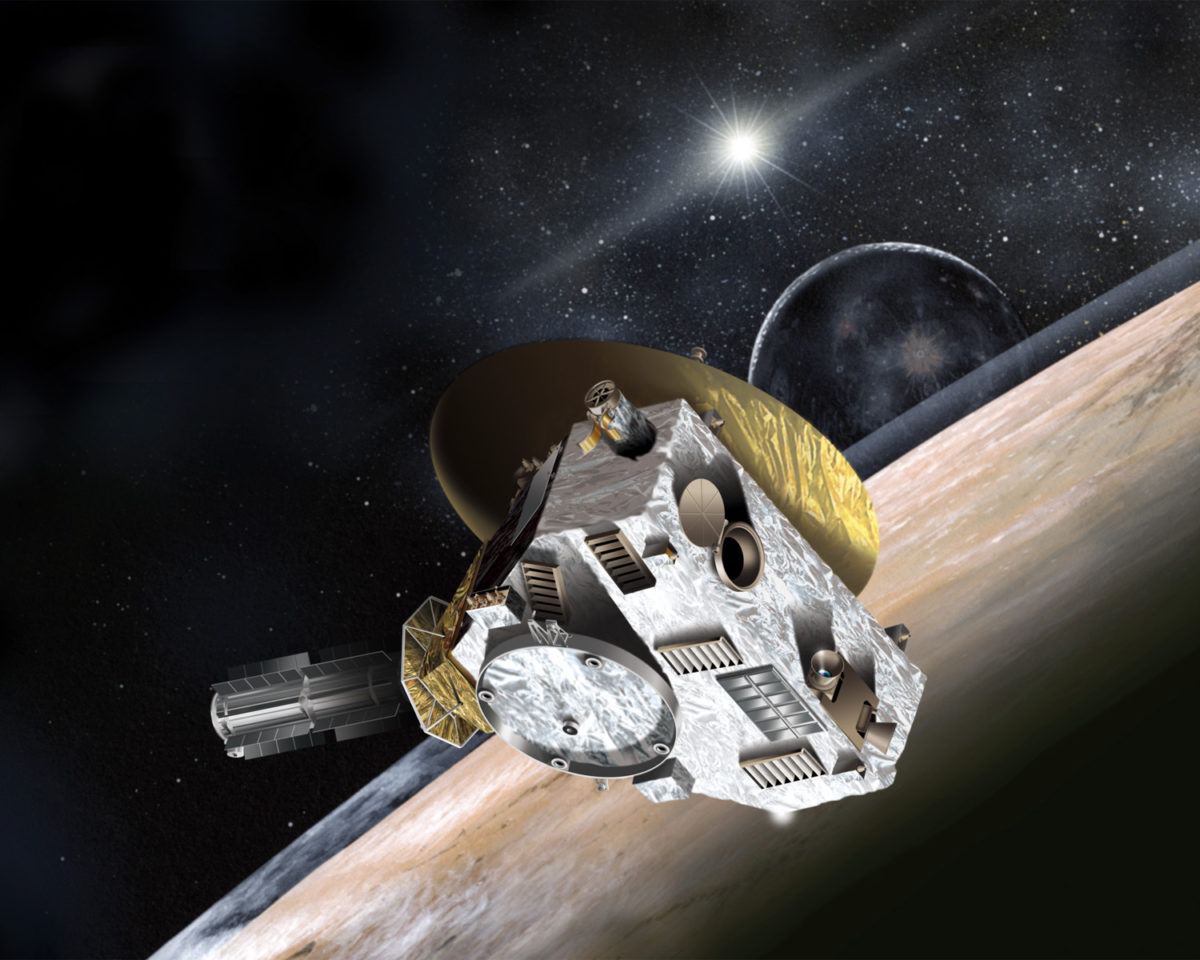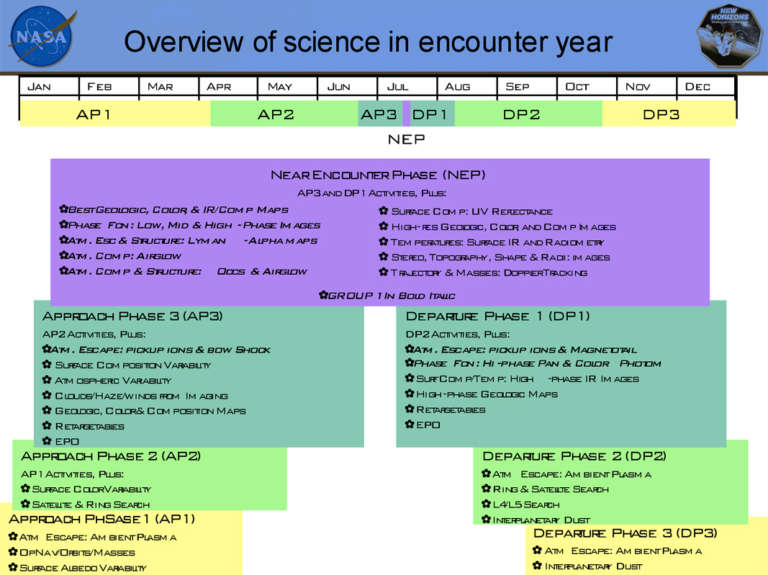Alan Stern • May 19, 2009
Ever Plan Ahead? How About Six Years Ahead?
As you may know, I am the Principal Investigator of New Horizons, NASA's mission to reconnoiter Pluto and Kuiper Belt Objects (KBOs) for the first time. New Horizons -- NASA's first New Frontiers mission -- launched in January 2006, and is now deep into its 9.5 year journey across the planetary system to reach Pluto in mid-2015 and KBOs in succeeding years.
You can check out this site for more background about the mission, but my purpose in writing about it today is to tell you about the work our team has been doing of late -- some very important work indeed.
You see, despite still being more than six years and just over 18 Astronomical Units from the Pluto system, the project team is conducting the second and final portion of our Pluto Encounter Preliminary Design Review (EPDR) tomorrow and the next day.
The first portion of the EPDR was conducted on 7 and 8 January. EPDR part two is another two day confab, in which the New Horizons technical and management team, will be presenting the detailed, minute by minute timelining of our planned 2015 Pluto encounter to a review team of expert planetary planners from across the nation. EPDR represents the culmination of almost two years of intense encounter planning involving the entire New Horizons science and mission team, and the stakes are high -- this is the main technical review of what will be taking place when we get to Pluto to explore it and its satellites for the first time.

You might wonder why we're planning the encounter so far in advance -- after all, it won't start in earnest for just over five and an half years as we begin our approach in early 2015. And in fact, when we first proposed and designed New Horizons, we didn't set out to do this work until 2012 and 2013 -- which would have been in time to test the sequence on the ground and then in a flight rehearsal before the curtain on this historic first exploration of an ice dwarf planet and its system of moons begins. But in early 2007, as we were culminating our in flight planning for our Jupiter encounter that year, one of our lead science sequencing gurus, Ann Harch, lamented to me that it was too bad that we has to wait 5 or 6 years, getting rusty all that time, before planning the Pluto encounter.
Ann's comment was brilliant and wise: for in one fell swoop she'd identified a theretofore undocumented mission risk. It didn't take us long to see how to eliminate this risk though: Just plan the encounter at Pluto right after completing our successful Jupiter encounter. (Why we hadn't thought of this before, I'll never know, but I can guarantee you that when we get to Pluto, I'll be nominating Ann for a NASA Exceptional Service Award.)
Well, regardless, I discussed this idea within the team, and people really liked it, so our Project Manager, Glen Fountain, of the Johns Hopkins Applied Physics Lab (APL) where New Horizons was built and is now operated out of, took it forward to NASA for approval, which was granted in the spring of 2007.

The only catch in NASA's approval: though the Agency was willing to spend some of our funds sooner to pay for the encounter planning in 2007-2008-2009, rather than in 2012-2013, there was to be no more money than we'd originally planned to spend, and we would have to finish the main portion of the encounter planning by the end of 2009 in order to remain on budget. Glen and I thought that was a pretty good trade and we accepted the challenge.
So beginning in the summer of 2007, we set out to plan an encounter that was then still 2 billion miles and almost a decade in the future. First off, the science team, led by our Pluto Encounter Planning (PEP) team boss Leslie Young, picked the best possible arrival date in mid-2015. The result, 14 July 2015 (Bastille Day!) gave us the best combination of encounter viewing of Pluto and its three moons of any day within the range of dates our fuel supply could allow us to reach.
Next the PEP team optimized the flyby closest approach distance to best study Pluto and all three of its known moons -- not to far away lest we lose resolution, but not too close lest we crowd the pace of events in close and smear images. In the end, we chose a closest approach 12,500 kilometers from Pluto.
Following that, PEP began detailing how each and every Pluto system scientific observation would be carried out by the various scientific instruments on New Horizons -- from mapping to composition studies to atmospheric escape, and on and on.
Then we wrote down all of the timeline requirements needed to fit these observations together, and traded or strategized our way out of the competing desires of our various instrument and science theme teams. Next up, we integrated hundreds of scientific observations during closest approach into a carefully choreographed encounter, feathering into that plan all of the final approach navigation, trajectory correction maneuvers, and communications requirements, and fitting all of this into the available command space memory, data recording memory, fuel budget, and so forth.
We also added backup observation opportunities for the most important science so that if a given observation failed, we got at least a second shot at it. And we added in a few artistic image sequences (such as a family portrait of Pluto in bound. and another as waning crescents as we go outbound.) This highly integrated and exquisitely choreographed plan was then put to a test on our mission simulator for testing. Having passed that milestone, it will be reviewed and critiqued by outside experts in the EPDR review this Thursday and Friday.
Following the EPDR, we will be waking up New Horizons for its 2009 checkout this July and August, and then we will return to encounter planning for the remainder of the year. So in the fall and early winter we will be finalizing the near encounter sequence by taking into account the actions cited by the EPDR review board and by also knocking off all the fine details of punch list ("to do") items that we ourselves still have to clean up before we put the plan in the can, where it will sit until 2013 or 2014 when we gear up for a full in-flight rehearsal of the central 9 days around our closest approach.
And so what is in store for the encounter? In total, we have approximately 30 specific scientific objectives planned -- from surface mapping to composition mapping to atmospheric studies to searches for new moons and rings. And in just the central 9 days around closest approach, over 380 observations are planned of Pluto, its moons Charon, Nix, and Hydra, and the space between and around this system.
And although the pace of activity and the highest resolution datasets will come in that 9 day "core encounter" period, the entire encounter New Horizons will last from January to July of 2015, allowing us to see Pluto and its moons in more and more detail as we fly up to them, and to study the way their surfaces and Pluto's atmosphere is varying over this long time span.
The figure just below is a top level view of how we sorted our various science objectives into the encounter's approach phases (APs), its Near Encounter Phase (NEP), and our Departure Phases (DPs).

And the figure just below shows a scorecard for how the detailed, minute by minute sequence our science team and planners have put together, meets or exceeds the objectives set for us by NASA many years ago.

That I've been able to tell you in this blog entry is just a top level summary of planning that has taken place by the New Horizons team for our encounter, still six years hence. We're anxiously looking forward to that day -- in the middle of the coming decade -- which will open up for study a new planet and whole new class of planetary bodies -- the dwarf planets -- on the unexplored frontier of the solar system.
Exploration is one of those things that makes us human, I think, and paraphrasing Dave Scott as he stepped onto the Moon to explore the Apollo 15 site: this is going to be exploration at its greatest!
Support our core enterprises
Your support powers our mission to explore worlds, find life, and defend Earth. You make all the difference when you make a gift. Give today!
Donate

 Explore Worlds
Explore Worlds Find Life
Find Life Defend Earth
Defend Earth

